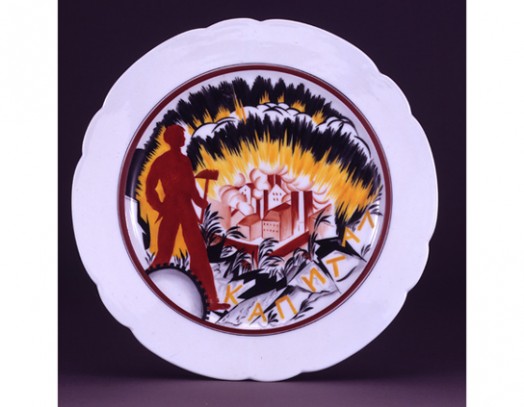
Symbolism and change
On the reverse of the plate are two marks: that of the Imperial Porcelain Factory, with the cipher NII for Nicholas II surmounted by a crown, dated 1901, and the hammer and sickle of the renamed State Porcelain Factory, dated 1921. In the years immediately following the Russian Revolution, very little new porcelain was manufactured in the state factory. Instead they added over-glaze decoration to the reserves of pre-revolution blank wares.
This re-use of imperial stock for revolutionary propaganda is symbolic, in itself, of the supremacy of the new order. It is further reinforced by the imagery of the decoration. The fine porcelain of the plate itself, with its scalloped rim, is subjugated by the over-size red silhouette of the worker holding a hammer; the explosive power of industrial development threatens to burst the conventions of its circular frame; capitalism is shown in disarray in the yellow lettering at the bottom. The historian Eric Hobsbawm comments: “In one object you can see the old regime and the new regime, and the change from the one to the other, and there are very few objects in which history is so clearly present before you.”
Industrial revolution and social revolution
The fifty years that preceded the revolutions of 1905 and 1917 stoked the pressures on the imperial system. Russia’s humiliation in the Crimean War dramatically exposed the country’s failure to engage with the technological and social advances of other European powers. After the war, Nicholas II’s grand-father, Alexander II, was forced to consider far-reaching reforms, including the abolition of serfdom and the introduction of a system of local assemblies in rural areas. He also commenced reform of the armed services and instituted new legal and penal codes. However, his intention to create a new class of self-motivated, efficient peasantry in the countryside remained to a great extent unfulfilled, with control of the economy still largely in the hands of aristocratic land-owners.
Alexander’s reforms were cut short by his assassination in Petrograd in 1881. The assassination was intended to scare his successor, Alexander III, into more fundamental change. In fact it had the reverse effect, and the new emperor reversed most of his father’s reforms. At the same time, progress in urban industrialisation presented a breeding ground for revolutionary ideas in cities ill-equipped to house and feed a rapidly growing industrial proletariat. Encouragement of foreign investment also meant that much of the newly created wealth from factories and mines was siphoned away from the country it was supposed to benefit. In response to the rising tide of discontent, Alexander tried to take control by diluting the authority of the rural assemblies instituted by his father and expanding the secret police and security services. On his death in 1894, he left his son, Nicholas II, with an empire falling still further behind the other great powers of Europe, and a people seething with discontent and frustration.
Transformation and compromise
The revolution of 1905 was the first expression of the combined discontent of all sectors of the proletarian population. They found support also from a militant student and intellectual cadre and a population of non-ethnic Russians smarting under a policy of enforced “russification”. Concessions such as the establishment of a multi-party political system, a two-tiered assembly and a limited constitutional monarchy proved only to be temporary flood barriers.
Following the revolutions of 1917, the continuing demands of Russia’s involvement in the First World War were compounded by the formation of anti-Bolshevik alliances both within Russia and externally. Five years of civil war finally ended in Bolshevik victory and the creation of the USSR in 1922. At this point the country was near ruin; its industrial infrastructure had essentially collapsed and severe droughts resulted in the great famine of 1921 – 22 that killed an estimated 6 million people. Against this back-drop the new government had to moderate its socialist programme in the face of harsh economic realities. The state capitalism of the New Economic Policy of the early 1920s allowed capitalist principles of the market economy and taxation partially to replace nationalisation of industry and requisitioning of produce. At the same time, however, propaganda served to maintain the impression of a pure socialist state both at home and, through plates like this which were made for export, abroad.
More information
BBC History of the world in 100 objects
Listen to the programme or read the transcript.
http://www.bbc.co.uk/ahistoryoftheworld/objects/QReTVeCrQBW86UScSIMAtw
Information about the Imperial Porcelain Factory
http://en.wikipedia.org/wiki/Imperial_Porcelain_Factory
Comprehensive information about the Russian Revolution
http://alphahistory.com/russianrevolution/
Article on Russian industrialisation
http://alphahistory.com/russianrevolution/russian-industrialisation/
Article on Russian avant-garde art
http://www.theguardian.com/artanddesign/2011/nov/04/russian-avant-garde-constructivists
More information
-
BBC History of the world in 100 objects
Listen to the programme or read the transcript.
Source: bbc.co.uk
-
Information about the Imperial Porcelain Factory
Source: en.wikipedia.org
-
Comprehensive information about the Russian Revolution
Source: alphahistory.com
-
Article on Russian industrialisation
Source: alphahistory.com
-
Article on Russian avant-garde art
Source: theguardian.com


